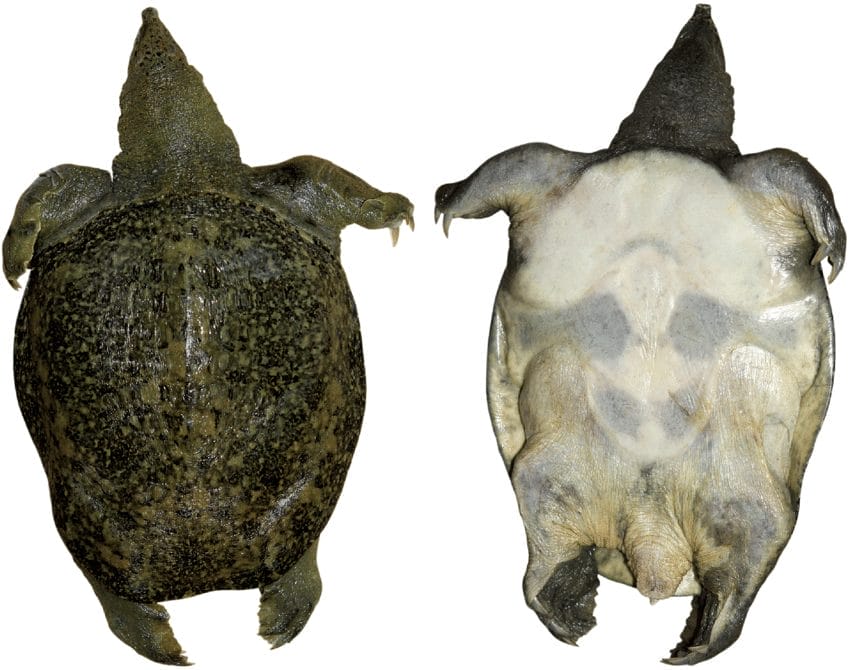Pelodiscus shipian (stone slab soft-shelled turtle)
Home > Turtle Database > Pelodiscus shipian (stone slab soft-shelled turtle)

Pelodiscus shipian, also known as the stone slab soft-shelled turtle, is a freshwater species found in China. It was only recently described and is known for its flattened shell and unique habitat preference.
Native Turtle Species Map – Find Turtles by Region
Scientific Classification
Kingdom: Animalia
Phylum: Chordata
Class: Reptilia
Order: Testudines
Family: Trionychidae
Genus: Pelodiscus
Species: P. shipian
Common Names
Stone slab soft-shelled turtle
This Hilarious Turtle Book Might Know Your Pet Better Than You Do
Let’s be real—most turtle care guides feel like reading a textbook written by a sleep-deprived zookeeper.
This one’s not that.
Told from the snarky point of view of a grumpy, judgmental turtle, 21 Turtle Truths You’ll Never Read in a Care Guide is packed with sarcasm, sass, and surprisingly useful insights.
And hey—you don’t have to commit to the whole thing just yet.
Grab 2 free truths from the ebook and get a taste of what your turtle really thinks about your setup, your food choices, and that weird plastic palm tree.
It’s funny, it’s honest, and if you’ve ever owned a turtle who glares at you like you’re the problem—you’ll feel seen.
Identification
Description
Pelodiscus shipian has a flattened, leathery shell that helps it blend with stone slabs in its habitat. Its shell is olive to brown with a rough texture. The head is broad with small eyes and a snorkel-like snout, typical of softshell turtles.
Sexual Dimorphism
Males are smaller with longer tails, while females grow larger with shorter tails. The size difference becomes more noticeable as they mature.
Check more turtles from the Pelodiscus genus
Native Origin and Distribution
Geographical Range
This species is native to Guangxi Province, China. It is known from a limited number of streams and rivers in that region.
Preferred Habitat
Pelodiscus shipian prefers shallow streams with rocky bottoms, especially areas with large stone slabs where it can hide. These turtles rely on clear, flowing water and stable rocky environments.
Behavior
Feeding Habits
It is carnivorous, feeding on small fish, insects, crustaceans, and mollusks. Its flattened body helps it ambush prey from beneath stone slabs.
Predators
Natural predators include birds, larger fish, and mammals. Human activities have also become a major threat.
Reproduction
Breeding Season
Breeding likely occurs in spring and early summer, though specific data on this species is limited.
Reproductive Method
The female lays eggs in sandy or soft soil near water. Like other softshell turtles, hatchlings emerge after incubation and make their way to the water.
Conservation
Extinction Status
Currently, Pelodiscus shipian is classified as Data Deficient by the IUCN.
Threats
Major threats include habitat destruction, pollution, and illegal harvesting for food and traditional medicine.
Conservation Measures
Protected areas have been established in parts of its range. Efforts are ongoing to monitor populations and regulate harvesting.
Economic Importance
This species is sometimes hunted for its meat and use in traditional Chinese medicine. Its rarity, though, limits its availability.
Interesting Facts
Pelodiscus shipian was only described in 2019, showing that new turtle species are still being discovered. Its name, “shipian,” means stone slab in Chinese, referring to its preferred hiding spots.

About Author
Muntaseer Rahman started keeping pet turtles back in 2013. He also owns the largest Turtle & Tortoise Facebook community in Bangladesh. These days he is mostly active on Facebook.













